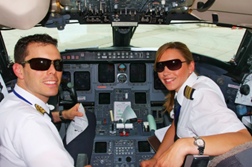 "The best safety device is the pilot, who, deep down, regardless of the aircraft, retains a sense of fallibility and vulnerability. No system can ever substitute for that," writes Arnold Reiner, a retired airline captain and former director of flight safety at Pan Am, in an op-ed published in the New York Times on 12/16/09.
"The best safety device is the pilot, who, deep down, regardless of the aircraft, retains a sense of fallibility and vulnerability. No system can ever substitute for that," writes Arnold Reiner, a retired airline captain and former director of flight safety at Pan Am, in an op-ed published in the New York Times on 12/16/09."What is chiefly needed is skill rather than machinery." —Wilbur Wright, 1902
They are two modes of flying—manual and automated. In the former, the pilot physically sets and changes parameters such as speed, height and direction, steering the aircraft from take-off to touchdown. In the automated mode the pilot keys commands into a computer in the cockpit to control these parameters.Pilot error has caused a number of accidents in the past few years, including the crash of a UN helicopter in 2008 that killed 10 people, a Kenya Airways plane crash in 2007 that killed 114 people on board, and the Colgan Air crash near Buffalo that killed all 49 aboard and a man on the ground.
But autopilot, like any other technology, is not infallible either. Airplane crashes have occurred when the plane was in automated mode.
The question is: Is autopilot error typically caused by the pilot, or is the equipment at fault?
"Designed to reduce crew workload and enhance safety, today's highly automated aircraft can leave pilots so detached from flying that they become almost like passengers on their own flights," writes Reiner. And pilots are often inadequately trained to fly a plane in autopilot mode.
In March 2010 India's aviation regulator said that most pilots in the country are not adequately trained to fly an aircraft in the automated mode, which is used on half of all domestic flights. "From now on they should fly their aircraft only in the manual mode until they train their pilots to operate the automated technology," said the Directorate General of Civil Aviation. Are US pilots adequately trained?
Taking into consideration that about 95 percent of all aircraft used by domestic carriers have automated systems of flying, the "Professionalism in Aviation" conference is past due.
In 2002 Captain Robert Sumwalt, Captain Ronald Thomas and Key Dismukes, chief scientist for Aerospace Human Factors NASA, wrote a paper titled "Enhancing Flight-crew Monitoring Skills Can Increase Flight Safety," which concluded that "inadequate flight crew monitoring has been cited by a number of sources as a problem for aviation safety. While it is true that humans are not naturally good monitors, we firmly believe that crew monitoring performance can be significantly improved through policy changes, training and by pilots following an active monitoring concept."
Because technology allows computers to perform a number of pilot functions, some experts believe that pilots can become distracted and even complacent. "The introduction of automation did good things," said Dismukes. "Now the pilot is a manager, which is good, and a monitor, which is not so good."
According to a 5/17/10 article in the New York Times, some airline pilots have confirmed this problem. "We've all been there, not intentionally, but because you get distracted from the task at hand," said a captain at Continental Airlines.
READ MORE AIRPLANE CRASH LEGAL NEWS
If a plane crash were caused not by pilot error but by automated failure, the airline, the airplane manufacturer, the engine manufacturer, aircraft instrument manufacturer and even the mechanic could be held responsible. It's likely that airlines would blame pilot error in the event of a plane crash or "incident," rather than blame inadequate autopilot training.
